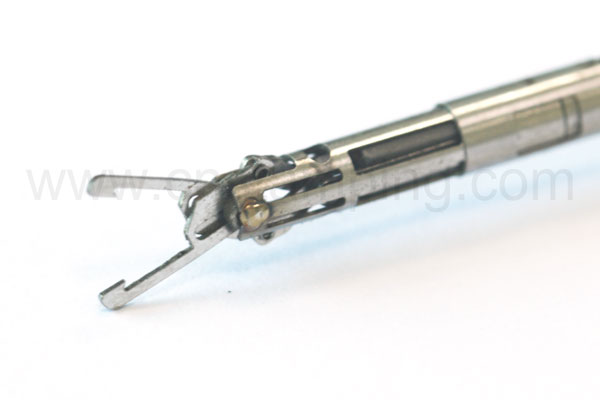Medical Device Stampings-Endoclips in Endoscopy
In medical endoscopy, a device called an endoclip is used to join two mucosal surfaces without the need for stitches or surgery. It is made of metal and functions mechanically. During surgery, a variation of the endoclip called a hemoclip is used to ligate tiny blood vessels, and it is also employed to mark the location of bodily structures during radiographic operations.
Metal endoclips come in various sizes, with most being rotatable and equipped with reopening and closing functions to ensure precise deployment. These clips efficiently achieve hemostasis by clamping the blood vessel and gently compressing the lesion’s edge without harming the surrounding tissue. For optimal results, it is recommended to apply the inner clip in a transverse direction across the blood vessel, using a sequential zipper pattern to repair any mucosal damage.
What are the Functions of Endoclips in Endoscopy?
The function of endoclip is like that of a suture in gross surgical applications, as it is used to join together two disjointed surfaces but can be applied via the channel of an endoscope under direct visualization.
Endoclips have been discovered to be beneficial in treating gastrointestinal bleeding, both in the lower and upper tracts. Additionally, they have been found to be effective in preventing bleeding after therapeutic procedures such as closing gastrointestinal perforations and polypectomy. The market offers a variety of endoclips, including two and three-prong options, which can be delivered through reloadable or single-use systems. Some of these devices can open and close to facilitate placement, while others do not.
Endoclips that are used today come in several shapes and sizes, different from the original. Clips with 2 and 3 prongs are used for various applications. To improve the accuracy of deployment, technicians have created rotatable clips. Additionally, clips that can open and close have been developed, making it easier to find the optimal location for deployment. In the event that an endoscopy reveals a treatable abnormality, an endoclip can be inserted through the endoscope channel until the covered clip is visible on the endoscopic image and then passed along to the nurse assistant. After pulling back on the handle to uncover the clip, it can be positioned and activated by the nurse to treat the abnormality.
The Applications of Endoclips
- Gastrointestinal Bleeding
Endoclips are mainly employed to halt bleeding (hemostasis) while operating on the gastrointestinal tract. Various types of bleeding lesions have been successfully clipped. For example, bleeding peptic ulcers must be treated endoscopically when they show signs of active bleeding.
- Other Applications
Endoclips have proven to be valuable tools in halting bleeding that may occur during intricate endoscopic procedures. In the case of preventing post-polypectomy bleeding, prophylactic clipping of the polyp base is an effective measure. Furthermore, clips can also be utilized to close gastrointestinal perforations that may arise from complex therapeutic endoscopy procedures such as polypectomy.
Endoscopic feeding tubes can also be secured with clips. Treating bleeding peptic ulcers with endoscopic hemoclips has proven to be a safe and effective method, boasting a high initial hemostatic rate of 95% and a low re-bleeding rate of 8%. Suppliers of hemoclip products are continuously developing new types of clips and clip application devices, making the treatment even more efficient and user-friendly.
About Hejustamping-Precision Medical Device Stampings Manufacturer in China
Heju Stamping has over 30 years of experience in precision metal stampings for the medical device industry. Certified by ISO9001 and ISO13485, we have expertise in medical devices and their related requirements. Additionally, we are proficient in the handling of medical grade metals and the precise cleaning and packaging requirements required by our medical customers.
Our senior engineers will design a customized solution based on the customer’s drawings. Using advanced stamping simulation technology to provide information for the design stage. In addition, we also guarantee a fast and efficient precision machining method with almost no waste.
After stamping, we clean and package all stamping components in a safe and clean environment, resulting in a full-service solution. Do you want to learn more about our medical capabilities? Please contact us today.
